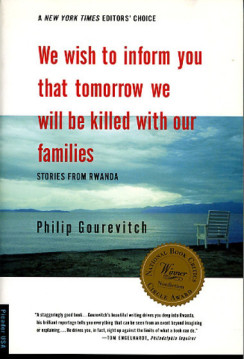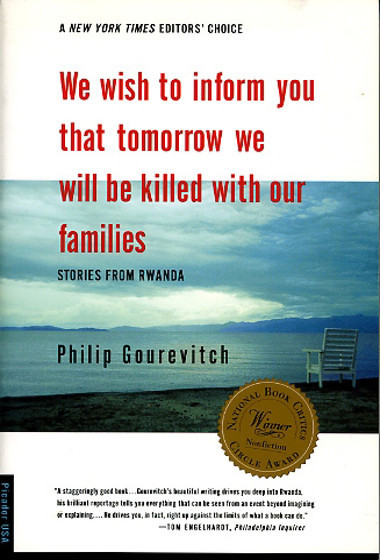
Memorial at Nyamata Church in Rwanda with blood-stained altar cloth | Image by Inisheer via Wikimedia Commons (http://bit.ly/1P6HVsi)
I didn’t know much about the Rwandan genocide when I went to Rwanda for the first time last week. It was the end of a trip in Africa, and I was in awe of the beauty of the country: terraced hills bearing banana trees and sweet potatoes and carrots; roads as smooth and well-paved as the best in America; people happy to teach you how to say “thank you” in Kinyarwanda, one of their three national languages. (It’s “Marakoze,” by the way.)
The role of religion in the genocide was one of its greatest shames, I came to learn as we visited the genocide museum in Kigali and heard a few stories from people who had lived through the 1994 massacre. Many churches in Rwanda–a majority-Catholic country–were initially seen as places of sanctuary, as churches often are during times of crisis. The Tutsi minority–who, along with the Hutu moderates, were the primary targets of the genocide–fled their homes and villages to take refuge in local churches, where they were often assured by parish priests that they would be safe.
They weren’t. At several churches, priests used their refugees like bargaining chips, exchanging information with the interahamwe militia in order to save their own lives. A nun who worked in a Butare hospital was arrested and jailed for her role in handing Tutsi refugees over to Hutu militiamen. One priest, Father Wenceslas Munyeshyaka, was tried and convicted in absentia for rape and murder, among other things, by the International Criminal Court. He lives in Gison, France, where he is a parish priest.
We just saw the 21st anniversary of the end of the Rwandan genocide. Many of the people responsible for acts of murder, mutilation, and rape, escaped across borders to neighboring countries in the summer of 1994 and have evaded justice since then. Many more were left with significant PTSD, with no families to speak of, and infected with HIV by their rapists.
 It’s not an easy thing to understand, but I wanted to draw your attention to one book in particular that does a great job of trying: We Wish to Inform You That Tomorrow We Will be Killed with Our Families, by Philip Gourevitch. It was published in 1998, close enough to the genocide that the author’s frequent trips there allowed him to observe many of its effects; the book opens on a scene with him visiting the corpse-ridden church at Nyarubuye, where an estimated 1500 citizens were killed in a 24-hour period in April 1994.
It’s not an easy thing to understand, but I wanted to draw your attention to one book in particular that does a great job of trying: We Wish to Inform You That Tomorrow We Will be Killed with Our Families, by Philip Gourevitch. It was published in 1998, close enough to the genocide that the author’s frequent trips there allowed him to observe many of its effects; the book opens on a scene with him visiting the corpse-ridden church at Nyarubuye, where an estimated 1500 citizens were killed in a 24-hour period in April 1994.
READ: Fall Book Roundup: Marilynne Robinson, Roxane Gay, and more
We Wish to Inform You is a compassionate, humane, complex look at the factors that created the conditions for the genocide to take place. It makes the case that the genocide was the result of an organized, long-term, sustained effort by the government–first German colonialists, then Belgians, then Rwandans–to foment hatred between the Tutsi and Hutu ethnic groups. It tells the stories of people who survived the genocide, and they tell the stories of the people who didn’t. It’s a wonderful book, well-reported and honest in its curiosity. For the last few weeks of summer, if you’re looking for a book to learn about something you may not know as much about as you wished–or just looking for some fantastic journalism–this is a great place to start.





